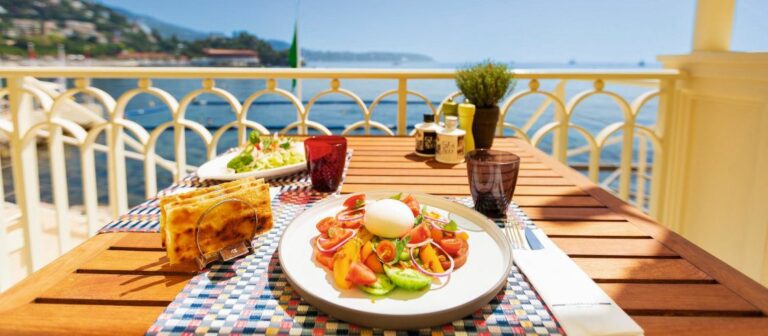Introduction: Understanding Monégasque cuisine
Monaco, a small principality on the Mediterranean coast, is known for its luxurious lifestyle, glamorous events, and beautiful scenery. However, its cuisine is equally captivating and reflective of the region’s unique identity. The Monégasque culinary scene is a blend of historical influences and international flavors, creating a diverse and vibrant food culture.
In this article, we will explore how Monégasque cuisine is influenced by its history and the international influences that have shaped its culinary landscape. We will also highlight some traditional Monégasque dishes and their origins, as well as the role of seafood in the local cuisine. Finally, we will take a look at how modern twists and innovations have brought new flavors and culinary experiences to Monaco.
The historical influences that shaped Monégasque cuisine
Monégasque cuisine has been shaped by a rich history, with influences from various cultures and civilizations that have left their mark on the region. The neighboring Italian and French cultures have had a significant impact on Monégasque cuisine, with traditional dishes such as socca, a thin pancake made from chickpea flour, and barbagiuan, a savory pastry filled with Swiss chard, ricotta, and Parmesan cheese.
The presence of the Grimaldi family, Monaco’s ruling dynasty, has also had an impact on the local cuisine. They brought with them a love of fine dining, which influenced the development of haute cuisine in the region. Additionally, the Grimaldis introduced new ingredients and cooking techniques to Monaco, such as olive oil and herbs from their Italian heritage.
A melting pot of international influences on Monégasque food
Monaco’s position as a global hub for cultural exchange and trade has contributed to the international influences on Monégasque cuisine. With residents from over 120 nationalities, the local cuisine has adopted flavors and techniques from around the world. The influence of Japanese cuisine, for example, can be seen in the popularity of sushi and sashimi in Monaco’s fine dining restaurants.
The influx of international visitors has also contributed to the popularization of fusion cuisine in Monaco. This style of cooking combines elements of different culinary traditions to create new and exciting dishes. The result is a culinary landscape that welcomes diversity and creativity, reflecting the cosmopolitan nature of the principality.
Traditional Monégasque dishes and their origins
In addition to the international influences, traditional Monégasque dishes remain a vital part of the local cuisine. One such dish is the bouillabaisse, a fish soup made with locally caught seafood and flavored with saffron and fennel. Another popular dish is the pissaladière, a pizza-like dish made with caramelized onions, anchovies, and olives, and often served as an appetizer.
Other traditional Monégasque dishes include the fougasse, a type of bread filled with bacon, olives, and cheese, and the pan bagnat, a sandwich filled with tuna, egg, and various vegetables. These dishes reflect the region’s Mediterranean heritage and the use of fresh, locally sourced ingredients.
The role of seafood in Monégasque cuisine
Seafood is a significant component of Monégasque cuisine, with many traditional dishes featuring locally sourced fish and seafood. The region’s position on the Mediterranean coast provides a wealth of fresh and diverse seafood, such as sea bream, dorade, and octopus.
One of the most popular seafood dishes in Monaco is the barbajuan de la mer, a variation of the traditional barbagiuan pastry, filled with salmon, spinach, and ricotta cheese. Another popular dish is the bouillabaisse, a flavorful fish soup made with various species of fish and seafood, and served with a side of rouille sauce and crusty bread.
Modern twists on Monégasque cuisine: fusion and innovation
Monégasque cuisine is not only rich in traditional dishes, but it also embraces innovation and contemporary twists. Many chefs in Monaco are experimenting with new flavors, techniques, and ingredients to create exciting and unique culinary experiences.
Fusion cuisine, for example, has become increasingly popular in Monaco, with chefs blending Monégasque and international flavors to create innovative dishes. Another trend is the focus on healthy and sustainable cuisine, with chefs using locally sourced and organic ingredients to create wholesome and flavorful dishes.
In conclusion, Monégasque cuisine is a fascinating culinary blend of historical influences and international flavors, with a focus on fresh and locally sourced ingredients. The region’s position as a global hub for cultural exchange and trade has contributed to its diverse culinary landscape, which welcomes creativity and innovation. Whether enjoying traditional dishes or exploring new and exciting flavors, the Monégasque cuisine is a reflection of the region’s unique identity and rich cultural heritage.

